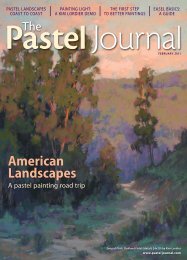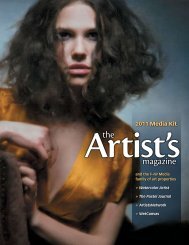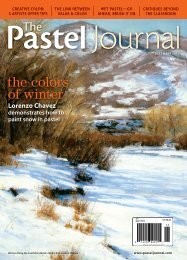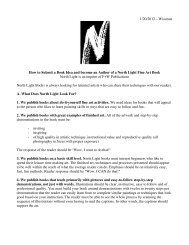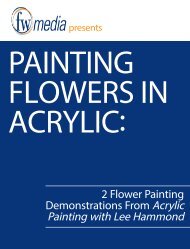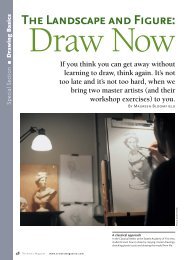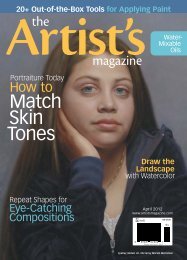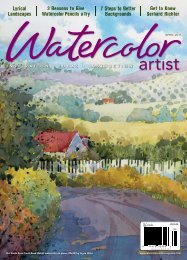Create successful ePaper yourself
Turn your PDF publications into a flip-book with our unique Google optimized e-Paper software.
The framework:• M is a compact manifold with corners.An example is [0, 1] n .We assume that each proper face H ⊂ M <strong>of</strong> maximal dimension(hyperface) is given by H = {x H = 0}, x H ≥ 0 on M,and dx H ≠ 0 on H.(Each hyperface has a defining function.)• M is the interior <strong>of</strong> M:M = M ∪H.We denote by Γ(E) the space <strong>of</strong> smooth sections <strong>of</strong> E, soΓ(T M) is the space <strong>of</strong> smooth vector fields on M.• V ⊂ Γ(T M) and [V, V] ⊂ V.2
It is quite common to find trees that mostly fall into visually symmetrical shapes such asalmost perfect ovals and even circles.4
One thing we need to remove from our thinking is trying to depict a tree in its realism. <strong>Trees</strong> areseveral stories tall and no painting will be able to convey their realism so we must think aboutdesigning trees into interesting shapes. In real life we don’t see a tree in one focus but in apainting we would because <strong>of</strong> the smaller scale. Too many artists try their best to copy paintings asthey appear in nature so they render them by painting many leaves and even copy theirsymmetrical shapes.This is a tree I did in my beginning months asa student. I tried to copy the photo. You cansee the shape is boring and I tried to renderleaves. I fell for all the traps. The foliage fitsin a circle which compromises its abstractshape.5
If you depict a tree that falls into a visually “circularish” shape no matter how well yourender it, the tree will not be appealing. Your best bet to create tree shapes that willend up being ovalish.Which <strong>of</strong> the two shapes is the more appealing, thesquare or the rectangle?6
If you group trees together thesymmetrical shapes will get lost in themass.8
Most pr<strong>of</strong>essional artists will group trees in families so theentire mass takes on an interesting shape.9
Notice that the three trees actually look like one with all their foliage mixingtogether. Novice artists tend to single out trees even when they appear in a group.Painting from Jim Wilcox10
Notice that the three trees actually look like one with all their foliage mixingtogether. Novice artists tend to single out trees even when they appear in a group.Painting from Jim Wilcox11
Watch out for cloned tree shapes. If that happens merge them together.12
When you do group trees together try not to single them out that much. Let them fusetogether. The left intellectual brain thinks in individual trees. The same applies to pinetrees and evergreen trees.13
Also grouping trees together makes it easier to <strong>of</strong>fset two equal sides. Visualizethe whole mass as one big tree or create just subtle differences between them.14
Nature does not <strong>of</strong>ten give us pleasing artistic shapes. It is a good idea to have a collection<strong>of</strong> tree shapes in a library that would qualify to be artistic and know as abstract shapes. Anartist is to become a shape collector. Your sense <strong>of</strong> esthetics to determine an attractiveshape should be innate.What constitutes an abstract shape for a tree?1. Draw an imaginary line down the middle and compare both sides. Both sides should bedifferent.2. The shape should not end up looking visually symmetrical by being close to a circle oran oval.3. The contour line should have lost & found edges.4. There should be color variances within the shape.5. There should be indentations and protrusions to show the 3D effect.6. When grouped together all the negative spaces that form between them should bedifferent.goodpoor15
When you compare both sides <strong>of</strong>this tree shape you see thatvisually the two sides are thesame even though scientificallythey are different. Take intoaccount that shape will even bemore symmetrical when viewedfrom a distance.16
This shape does not havemirrored sides.17
Fitting trees into alimited pictorial space18
It is a common policy for artists to crop trees either at the top or on the sides.The advantage <strong>of</strong> this is that this immediately <strong>of</strong>fsets any similar side and alsowhen cropped <strong>of</strong>f at the top on one side and a tree showing the top part on theopposite side we avoid competing areas. When cropping trees go for the 1/3 or2/3 ratio.19
It is not recommendable to have trees on opposite sides showing the partcontour. This makes the eye wander too much in the sky.20
By cropping <strong>of</strong>f the top <strong>of</strong> one <strong>of</strong> the trees this can dramatically improve yourscene.21
Also close large gaps on the side <strong>of</strong> your tree where you don’t want the viewerto go. You can leave a small gap as long as you don’t feel you get trapped in it.By zooming in this way it keeps the eye from wandering around in the sky.22
How to handle theircontour.23
One common problem is that a tree line tends to become visually a straightline, especially at a distance. This will disturb the viewer.24
To help you avoid this, think <strong>of</strong> your trees as buildings in which all theirheights and negative spaces are different. This will create a melodic line.25
Tip: Turn yourpainting upside downoccasionally to checkfor repeated negativespace.26
The viewer unconsciously likes to explore the spaces, indentations andprotrusions <strong>of</strong> trees.27
Make sure you also pay attention to the “cut ins” in your tree lines.28
How to project treesin a 3D format29
Also, visually trees can easily end up like ducks in a row where they meet land. Thiswill not work in a painting because the visual movement <strong>of</strong> the line is too fast andthe end result would be that the grass area would resemble a rectangle.Tip: Think <strong>of</strong> yourpainting as a chessgame that’s already inprogress with its piecesalready in front <strong>of</strong>others at randomspots.30
Now this is conveying depth!31
Avoid competing &boring contour lines.33
Also, when possible minimize a competing line that normally appears when there aremountains or hills. The viewer feels confused which <strong>of</strong> the two lines he is to follow. Evenif the line does not run parallel it still pulls the eye away from the tree area. What youcan do is lighten the value <strong>of</strong> the hill if you still want to keep it.34
What you can do is lighten the value <strong>of</strong> the hill if you still want to keep it.35
Or crop it.36
Or have the trees go higher than the hill line.37
Prioritizing a treemass.38
As we learned in the “Painting Stunning Landscapes from Photos”, it is a good idea tobudget the masses and not try say everything in the same painting. In this photo wehave three competing masses, the sky, the water and the trees. If you decide whichmass gets more square inches you have better chances <strong>of</strong> ending up with a successfulpainting.39
In this case I would be interested in emphasizing the water, the tree being thesecondary mass and the hill has lost almost all <strong>of</strong> its attention.40
In this photo I intend to speak more about the trees41
Think artistically notrealistically.42
One easy way to avoid over rendering, is to imagine the trees in the photo on the rightare made <strong>of</strong> plastic and you take a blow torch and apply it to the foliage. As soon as theindividuals leaves melt together you remove the heat. There should be no concernwhat happens inside the shape with the exception <strong>of</strong> color shifts. Pr<strong>of</strong>essional artistsare more concerned with the contour <strong>of</strong> the shape than the detail <strong>of</strong> it.43
Notice the melting <strong>of</strong> the foliage. The leaves that would appear at the contour areusually done by dry brushing so you paint dozens <strong>of</strong> leaves in one brush stroke44
Notice how just by skipping a brush loaded with heavy paint produces the brokenleaf effect. Also this is necessary to avoid your trees from looking pruned.45
Handling the color <strong>of</strong>trees.46
Summer scenes are probably the worst and moredifficult to paint because the greens become quitemonochromatic making it very difficult to pull <strong>of</strong>f aninteresting painting. By combing references I endedup with the colors I wanted.47
You will hear in workshops about creating sky holes in trees to give a loose airy look. However if youcreate many little sky holes as seen in nature your painting will look too spotty and will disturb theviewer’s eye. It is better to create large sky gaps which will still help your trees from looking pastedon. Make sure each sky gap is different in size. Fill in with solid paint all the tiny sky holes. If you dopaint a small sky hole make its value darker than the surrounding sky because the value contrastwith the darker trees will make the hole appear lighter.48
Autumn trees are tricky because you can get so many colors that you run the risk <strong>of</strong> making yourpainting too busy. The easiest solution is to work with an analogous color scheme. If you do notpaint red trees you will still be in the harmony <strong>of</strong> adjacent hues. I would also not paint pure greenhue. You can paint red trees but then it would be good to exclude yellow, yellow green and green.49
Here is a recommended palette you can use forfoliage. I left white out for obvious reasons. Idid not include colors that would be used foratmospheric perspective which would includeultramarine blue and Indian red to mix alavender.Summer greensAutumn oranges, ochres and redscadmium redcadmium yellowcadmium yellowyellow ochre paleyellow ochre paleburnt siennaburnt siennaIndian redviridianwinsor orange50
Here is a recommended palette you can use forfoliage. I left white out for obvious reasons. Idid not include colors that would be used foratmospheric perspective which would includeultramarine blue and Indian red to mix alavender.Summer greensAutumn oranges, ochres and redscadmium redcadmium yellowcadmium yellowyellow ochre paleyellow ochre paleburnt siennaburnt siennaIndian redviridianwinsor orange51
Indian redSuggested watercolor palette. The 5colors on the left are the work horsepigments. I use cobalt blue for skies andpermanent red mixed with tranparentyellow gives me a stronger orage.transparent yellowraw siennaburnt siennacobalt blueultramarine bluepermanent rose52
This painting has no green hue whatsoever. As a result we have a very harmoniouscolor choice.53
<strong>Trees</strong> <strong>of</strong>fer an excellent opportunity for texture. The larger the painting the more textureit can bear. You can even use modeling paste where you intend to paint the tree. Fastdrying white is also excellent for building texture. All this helps convey the idea that parts<strong>of</strong> your trees protrude. I have used dry paint ground down to small chips for very largepaintings to represent leaves. Also try using under-painting white for the close up trees.Tip: If you darkenthe side <strong>of</strong> the lasttree in a row it willlook more 3D.The rule <strong>of</strong> thumb is thelarger the painting themore you can get awaywith impasto. Smallpainting should havereduced texture.54
Nature will provide you with many tree branches. These have to be dramatically reduced and whenyou do depict them, just allow the eye to follow the tree trunks or branches just a short distanceand then slow down the quick eye flow by having the tree limb go under the foliage once again. Thereason for this is that any line becomes a visual path and the idea is to move the viewer slowly inthe painting.55
Tip: Avoid long treetrunks that haveangles <strong>of</strong> 90degrees from theground.56
When you create foliage backgrounds think front to back and create more planes toshow depth. The worst thing you can do is line up all your tree like ducks in a row.There is n<strong>of</strong>eeling <strong>of</strong> depthin this photo.57
Think front to backnot side to side.58
When you create foliage backgrounds think front to back and create more planes toshow depth. The worst thing you can do is line up all your tree like ducks in a row.59



